Smart Classroom Management: The 3-Step Ultimate Restart Guide
Every educator knows that a well-managed classroom is the bedrock of effective teaching and engaged learning. Yet, the ever-evolving dynamics of 21st-century classrooms present a slew of challenges. From managing digital distractions to addressing diverse learning styles, it’s no wonder that many educators feel the pressure.
- Why Reset? Reboots help clear outdated practices, making way for innovative approaches.
- Smart Management: Leveraging tools and techniques that align with today’s digital-native students.
- Harnessing Technology: With platforms like ClassPoint, engaging students becomes second nature.
If you’re pondering a smart classroom management restart, or simply seeking fresh strategies to invigorate your teaching style, this guide holds the keys. Read on and take the first step towards a revitalized classroom experience!
The Challenges of Classroom Management

Ah, the modern classroom. It’s a vibrant, bustling hub filled with tech-savvy students and infinite possibilities. Yet, it’s also fraught with challenges that, at times, can make smart classroom management seem like an elusive goal. Let’s dissect the core issues educators grapple with:
Tech Overload
Today’s students, often dubbed “digital natives,” come armed with smartphones, smartwatches, and an arsenal of apps. Managing this digital landscape isn’t always easy.
In fact, a study by the Pew Research Center found that 95% of teens have access to a smartphone, leading to potential distractions in class.
Diverse Learning Styles
Not every student digests information the same way. Some are visual learners, while others are auditory or kinesthetic. Crafting a classroom management style that caters to all these preferences? It’s like juggling while riding a unicycle.
Setting Clear Boundaries
How do you strike a balance between being approachable and maintaining discipline? This tightrope walk can be particularly daunting, especially with disruptions being a recurrent theme.
According to a report by the National Center for Education Statistics, nearly 10% of public school teachers reported being threatened with injury by a student.
Keeping Up with Evolving EdTech
It’s not just about managing students; it’s also about mastering the classroom management tools of the trade. Platforms like ClassPoint are revolutionizing teaching methods, but staying updated requires effort.
The Need for a Reset
With these challenges in mind, it’s clear why a “restart” in classroom management is not just beneficial, but essential. But fear not, because this guide is all about that smart classroom management how-to – starting over in three focused steps.
Evaluating Existing Classroom Management Strategies
One doesn’t simply walk into Mordor, and neither does one leap into crafting a classroom management plan without first assessing what’s already in place. Just as every journey requires a starting point, every effective classroom management plan requires a clear understanding of current practices.
The ‘Why’ Behind Evaluation
Before diving deep into evaluation methods, let’s address the elephant in the room: Why evaluate? It’s not about highlighting shortcomings or playing the blame game. It’s about growth. It’s about ensuring that teaching techniques are in sync with students’ evolving needs.
A study by the Education Endowment Foundation found that consistent classroom management can advance a student's academic progress by up to four months in a single school year.
The Classroom Strategy Checklist
In the spirit of staying organized (and who doesn’t love a good checklist?), here are some pointers to kick-start your evaluation process:
–lead magnet here–
Potential Pitfalls of Sticking to the Old
Resisting change is human nature. But clinging to outdated classroom management strategies can lead to:
- Decreased student engagement
- Inefficient use of technological tools
- Difficulty in handling classroom disruptions
For instance, a report by McKinsey revealed that educators who adapt and innovate based on feedback and self-evaluation are more effective in driving student outcomes. Sticking to the "we've always done it this way" mindset can spell stagnation.
The Bridge to Betterment
Identifying what works and what doesn’t is just the precursor. The real magic happens when educators take this knowledge, coupled with insights on smart classroom management and how to start over in three steps, and use it to fuel positive transformation.

Step One: Identifying Pain Points
Every teacher knows that a classroom’s dynamics are as varied as the students it houses. Not all challenges are immediately apparent, and sometimes, it’s the underlying issues that can cause the most disruption. But how do you uncover these hidden culprits? It starts with a deep dive into identifying classroom pain points.
Why Pinpointing Specific Challenges is Crucial
It’s a principle as old as teaching itself: you can’t fix what you don’t know. Identifying specific issues enables targeted intervention, ensuring efforts are channeled where they’re most needed.
Common Classroom Pain Points
- Disruptive Behavior: A classroom’s harmony can quickly be thrown off by disruptions. Research by Classroom Management reveals that a significant portion of class time can be lost due to behavioral disruptions.
- Disengaged Students: Disengagement isn’t just about daydreaming. A student constantly looking at the clock or frequently asking for bathroom breaks can indicate a disconnect from the material or teaching style.
- Tech Troubles: In an age where digital and AI tools are integral to learning, technical hiccups can halt lessons in their tracks. Are students struggling with the tools provided? Is the tech serving its purpose, or is it more of a hindrance?
Connecting Pain Points to Action
Identifying these challenges isn’t an end but a means. By understanding specific problems and providing effective feedback, educators can grab students’ attention more effectively. Think of it as tuning a radio: once you hit the right frequency (or in this case, the right strategy), the static disappears, and you get a clear channel.
Step Two: Building a Smart Classroom Management Plan
Alright, you’ve tackled the challenges and pin-pointed those classroom pain points. But what’s next? Addressing these issues requires more than just intent; it demands a structured, actionable plan.
Here’s how to build a smart classroom management plan that’s tailored to your unique needs.
The Power of Goal Setting
If you’re not aiming at anything, you’ll land nowhere. According to a study by Dominican University, individuals with written goals are 42% more likely to achieve them. Imagine the transformative power this can have in a classroom setting!
Setting Clear Objectives
- Behavioral Benchmarks: Are you looking to reduce disruptions in the classroom? If so, set a target. Maybe you’re aiming for a 50% reduction in outbursts over a semester. Measurable goals make progress tangible.
- Engagement Enhancements: Strive for increased student participation. This could mean more hands raised during discussions or higher completion rates for in-class activities.
- Tech Integration: As the modern classroom evolves, integrating technology effectively is paramount. Aim for smoother transitions between digital tools or higher student proficiency with specific software.
Innovating with Modern Techniques
With the advancement in edtech, the avenues for innovative classroom management have widened. Platforms like ClassPoint allow for real-time assessment and interaction, which can dramatically shift classroom dynamics.
By actively seeking out these innovative solutions, educators can keep the classroom environment fresh and responsive to evolving student needs.
Step Three: Implementing Effective Strategies

So, you’ve built that smart classroom management plan. Now comes the real test: Implementation. Making the leap from plans to practical application isn’t always a walk in the park, but with precise strategies and an understanding of your unique classroom needs, success is within reach.
Customization is Key
Every classroom is a universe unto itself, with its own challenges and dynamics. According to a report by the Center for Public Education, tailored strategies that recognize student diversity have shown the highest efficacy rates. Here’s how to tap into that power:
Tailoring Strategies to Specific Needs
- Age-Appropriate Techniques: Preschoolers might respond well to visual aids and tangible rewards, whereas middle and high-schoolers might prefer autonomy and peer-led initiatives. Recognizing these age-specific needs is crucial.
- Cultural Considerations: Respect and inclusivity should underpin every strategy. This might mean understanding cultural festivals, behavioral norms, or language nuances.
- Learning Styles: Some students are visual learners, others auditory or kinesthetic. Tailoring your methods to accommodate these styles can significantly boost engagement.
Maximizing Engagement
A study by Gallup revealed that only one-third of U.S. high school students felt engaged in school. To address this, let’s dive into strategies to up those numbers:
Engaging Students and Fostering Participation
- Real-World Relevance: Create lesson plans that tie into current events or relatable scenarios. When students see the practical application, their interest piques.
- Interactive Tools: Platforms like ClassPoint can revamp lessons into interactive experiences, offering instant feedback and promoting participation.
- Fostering a Safe Environment: Encourage open dialogue, respect differing viewpoints, and ensure every student feels their voice is valued.
Executing the Restart
Hit a snag in your classroom management plan? No worries. Sometimes, a reset is exactly what the doctor ordered. Rebooting classroom dynamics can be as refreshing as a computer restart, clearing the bugs and setting the stage for a smoother experience. But how do we execute this restart effectively?
Why a Restart Might Be Necessary
First, let’s explore why the status quo may not always be working.
- Shifting Dynamics: As per a study by the University of Oregon, classroom dynamics can change over an academic year due to various factors like students’ personal issues or external events.
- Evolving Curriculum: The curriculum might evolve, introducing complexities that demand a shift in management tactics.
- Feedback Loop: Continuous feedback from students might indicate that the existing strategies aren’t resonating as expected.
Steps to a Successful Restart
Embarking on a classroom overhaul can seem daunting, but by breaking it down, the task becomes more manageable and effective.
Review and Reflect
- Gather Feedback: Conduct anonymous surveys to get candid feedback from students. Understand where the pain points lie.
- Self-Assessment: Reflect on your strategies. What worked? What didn’t? Be honest in your evaluation.
Plan the Changes
- Set Clear Goals: Define what you want to achieve with this restart. It could be improving participation, bettering student performance, or enhancing overall class harmony.
- Prioritize Actions: Not everything needs an overhaul. Identify key areas that need immediate attention.
Engage Stakeholders
- Parental Involvement: Engage with parents, informing them of the changes and seeking their support. They can be crucial allies in executing a restart.
- Student Participation: Involve students in the change process. When they feel they are a part of the decision-making, buy-in is easier.
Introduce the Changes Gradually
- Pilot Phase: Instead of a complete overhaul, introduce changes in phases. Test out new strategies on select topics or days, gauge their effectiveness, and then roll them out fully.
- Open Communication: Keep the lines of communication open. Inform students about the changes, why they’re being made, and what’s expected of them.
Monitor and Adjust
- Regular Check-ins: Post-restart, continuously assess the effectiveness of the changes. Tools like Classroom Assessment Scoring System (CLASS) can be invaluable here.
- Flexibility: Be prepared to tweak strategies based on feedback and observations. It’s a dynamic process.
Restarting can breathe fresh life into a stagnating classroom environment. While the idea might seem challenging, the rewards—enhanced learning, happier students, and a more harmonious classroom—make the effort worthwhile.
Remember, the aim is to foster an environment where both the teacher and students thrive.
Integrating ClassPoint into Your Smart Classroom Management Plan
When it comes to modern classroom management, technology isn’t just an accessory—it’s a driving force. And among the top-tier tools available, ClassPoint stands out as a game-changer for educators looking to elevate their teaching approach.
Here’s how you can seamlessly incorporate ClassPoint into your smart classroom management strategy:
- Manage Your Class Directly from PowerPoint: ClassPoint’s “My Class” integrates seamlessly with PowerPoint, allowing teachers to keep track of student progress and manage student behaviours effectively with point system and levels without exiting PowerPoint.
- Keep Your Class Engaged with Gamification Features: ClassPoint’s gamified system empowers teachers with the tools to reward participation with stars, drive students through levels and onto dynamic leaderboards, making learning both fun and rewarding.
- Effortless Attendance Checks: No need to waste precious lesson time on manual roll calls. With a few clicks, ClassPoint’s Name Picker lets you quickly check who’s present, allowing you to dive right into the day’s topic.
- From Well-Managed Time to Well-Managed Class: ClassPoint’s PowerPoint timer is the perfect companion for classroom management, facilitating productive teaching, streamlined classroom procedures, as well as well-structured presentations.
- Emphasize Key Concepts with Annotations: Visual reinforcement can make complex topics more digestible. Use ClassPoint’s flexible and highly customisable annotation features to underline, highlight, or circle pivotal points during your presentation.
- Instant Feedback with Interactive Quizzes: Gone are the days when you’d have to wait to grade papers to gauge student comprehension. With ClassPoint’s interactive quizzes, receive real-time responses and adjust your lesson pace accordingly.
- Engage Through Live Polling: Spark curiosity and encourage participation by integrating live polls into your lessons. It’s an excellent way to break the monotony and gather student opinions on the fly.
ClassPoint isn't just a tech tool; it's an ally in your smart classroom management journey. By leveraging its features, you’re not only enhancing lesson delivery but also actively creating an environment where students are eager to participate and learn.
So, as you reset and refine your classroom strategies, consider ClassPoint as a cornerstone for innovation and engagement. Discover how to turn your PowerPoint teaching into an interactive experience with ClassPoint.
Frequently Asked Questions
What is a SMART goal for classroom management?
A SMART goal for classroom management isn’t just a fancy acronym. It’s about setting a clear intention. For example, instead of saying, “I want fewer disruptions,” you might say, “By the end of the month, I aim to reduce classroom interruptions during lectures by 50%.”
It’s all about being specific and giving yourself a realistic and measurable target.
How can SMART classroom management bring instant calm to your classroom?
You know those moments when the classroom feels like it’s about to erupt? Smart classroom management techniques can be lifesavers. With consistent routines, students know what’s coming next, removing the element of surprise.
When you acknowledge and reward good behavior, students often want to keep the calm vibes going. And the way you communicate matters too. A calm tone, even in the midst of chaos, can help soothe even the rowdiest of classes.
What are the benefits of using technology in classroom management?
Tech isn’t just about flashy gadgets. In classroom management, it’s about enriching the learning experience. With technology, lessons can be interactive and engaging, holding the students’ attention.
You can also gauge how well students are understanding topics in real-time, giving them help right when they need it. And when it comes to grading? Technology can help streamline that, making feedback swift and personalized.
How to address disruptive students effectively?
Disruptive students can be a puzzle, but there’s often more beneath the surface. Maybe they’re facing personal issues or struggling with the material. It’s key to get to the root of their behavior.
Once you understand, you can tailor your approach, whether it’s through setting clear expectations or making lessons more hands-on and engaging. Refer to this classroom management plan designed based on Reesponse-to-Intervention approach that is ideal for managing disruptive student behaviour.
Engaging students creatively in the learning process involves?
Creative engagement is like adding a bit of magic to your lessons. Think of turning lessons into games or challenges, making learning feel like an adventure.
Platforms like ClassPoint can make presentations come alive, and don’t forget the power of real-world examples. When students see how their lessons apply in the real world, it can spark genuine excitement.
Can smart classroom management apply to online teaching?
Absolutely! Online doesn’t mean disconnected. Tools designed for classrooms, like ClassPoint, work wonders in virtual spaces too.
Just as in a physical classroom, it’s essential to set clear expectations for respect and participation, ensuring everyone feels valued and heard.
How to measure classroom management strategy success?
The proof is in the pudding, right? Get feedback from students and parents – they’ll offer invaluable insights. Watch for academic improvement; when students thrive, it often means your strategies are on point.
And don’t forget about class participation; when students are engaged and invested, you know you’re doing something right.
Your Journey to Effective Classroom Management
Classroom management goes beyond order; it’s about fostering a motivating learning environment. With modern challenges, the right tools and strategies are crucial. ClassPoint stands out in this regard. It offers solutions to enhance engagement, bridge in-person and online lessons, and streamline teaching processes.
As you navigate the complexities of classroom management, remember that tools like ClassPoint can be your compass, directing you towards effective and innovative teaching methods. Embrace the blend of technology and intentionality, and let ClassPoint help elevate your classroom experience.
Comments
Post a Comment